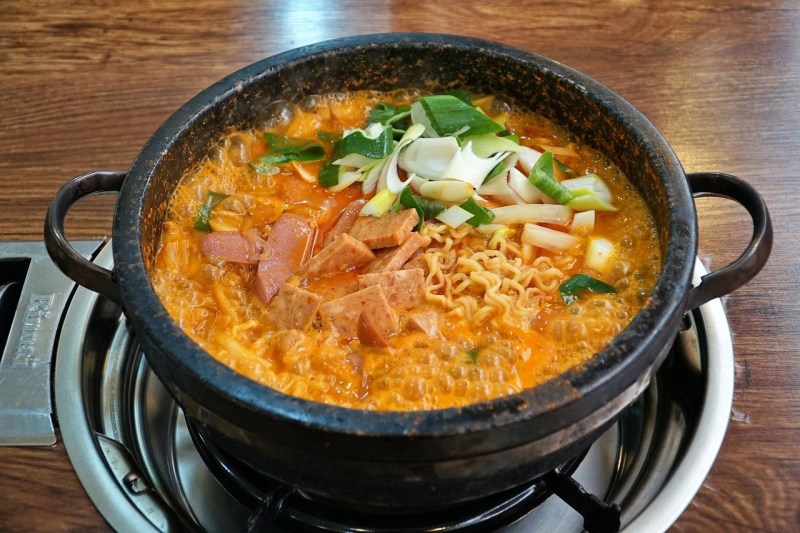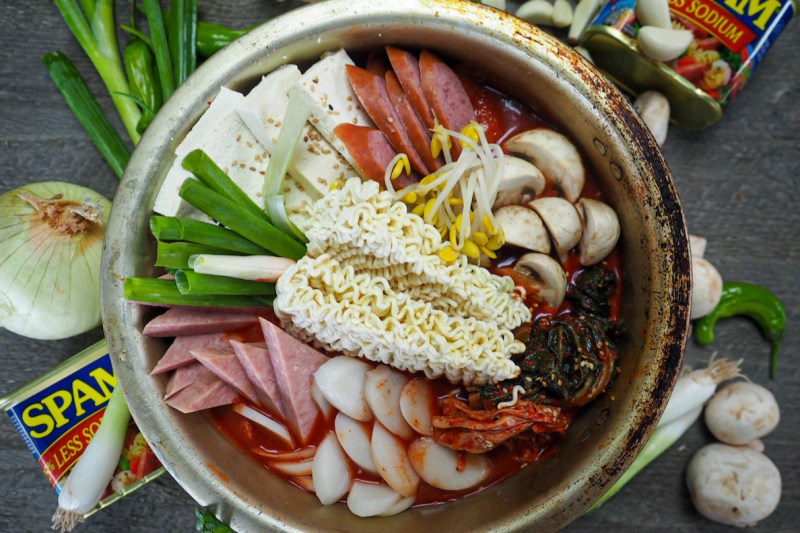
An eccentric, umami-packed dish, Korean Army Stew (Budae Jjigae) combines Korean culinary techniques and flavors with a distinctive American flair. A hearty stew made from kimchi, vegetables, and instant ramen cooked with Spam and American cheese, Army Stew is a unique combination of cultures, history and necessity.
Here to help guide The Manual on this unique Korean dish is Andrew Lim, executive chef of Perilla, a Korean American restaurant in Chicago.
Related Guides
The American Connection

The origins of Army Stew can be traced to aftershocks of the Korean War (1950-1953). The widespread devastation of the war affected every aspect of Korea as both the economy and infrastructure saw crippling destruction. As a result, hunger was a widespread issue as countless Koreans struggled to feed their families. Meat was a rare delicacy during this time, a far cry from the bounty of Korean barbecue and fried chicken restaurants that blanket modern South Korea.
However, there was one location in South Korea that had an abundance of meat — the U.S. Army bases. The American military remained in South Korea after the war and these bases often had a surplus of processed foods, especially meat products like Spam and hot dogs. Because of these meat surpluses, Koreans often bought or scavenged these leftovers from the American bases. Despite the exotic nature of these products, Koreans started to cook these unfamiliar ingredients in a familiar way — as a spicy stew rich with vegetables and kimchi. It was an instant hit. The marriage of ingredients was perfect as the salty, processed meats bonded well with the spicy and fermented flavors of Korean stews.
For decades, Korea remained a developing country and meat continued to be a relatively expensive ingredient. This meant that the processed meats in Army Stew remained important. Eventually, these ingredients grew from a survival necessity to a comfort food enjoyed both at home and in restaurants. Today, Korea is no longer a poor, war-torn nation. Yet, Army Stew remains popular, evolving to be an integral part of the Korean culinary fabric.
The Culture of Army Stew
A key feature of Army Stew is its flexibility. Besides the addition of Spam and other processed meats, fresh slices of pork belly and even baked beans can be added. In recent years, cheese has become a common ingredient in Korea and it can be common to find slices of American cheese in the bubbling cauldrons of Army Stew. Ingredients can also vary depending on individual family recipes. For Chef Lim, his father’s Army Stew recipe often called for canned mackerel in addition to the usual suspects.
Another important feature of Army Stew is its communal nature. Like most Korean stews, Army Stew is eaten simmering table-side on a portable burner as a communal meal. Modern Korea has also become famous for its robust nightlife and one of the most popular drinking foods is Army Stew, often consumed alongside plenty of alcohol.
“We would order our ten-dollar bottle of soju — that would gave you eight shots,” said Lim. “Then you get a big pot of stew and some kimchi fried rice. You would share this among three to four people and you walk out of there spending 15-20 bucks. That’ll get you hammered and full.”
Chef Andrew Lim’s ‘Army Stew’

Chef Lim’s restaurant Perilla (recently awarded a Bib Gourmand award for 2021) is named after the resilient plant native to Korea and many East Asian countries, Perilla is an homage to the parents of Chef Lim and his managing partner, Thomas Oh, who are first-generation immigrants who traveled to a foreign land and rooted themselves in new soil. Lim’s goal for Perilla is to showcase Korean cuisine in a new light, with high-end ingredients and unconventional techniques.
This Army Stew recipe from Lim is a perfect example of the free flowing nature of the dish. “There’s no real singular recipe that is Budae Jjigae,” said Lim. “Its kind of like bibimbap (mixed rice) — there’s no real recipe for it. Budae Jjigae is kind of the same idea. You get whatever you have in the fridge and throw it in the pot. My dad would make that for us pretty often when we were kids. Either he loved it or he was too lazy to make dinner for us.”
Ingredients:
For broth:
- 2-3 cups kimchi juice
- 2-3 cups dashi/chicken/beef stock (can be purchased at grocery store)
- 1-2 tbsp salt
Broth Ingredients:
- 8-10 oz kimchi (the older, the better), cut into half-inch chunks
- 2-3 tbsp minced garlic
- 2 cups sliced onions
- 2 sliced, bite-sized sausage
- 1/2 can Spam, cut into half and sliced
- 1 cup rice cakes
- 1 cup cubed tofu
- 1 cup sliced mushrooms
- 1 cup sliced scallions
- 1 package, ramen noodles
- 2 slices American cheese
Method:
- Add the kimchi juice and stock to a stockpot and turn the heat to high. Add salt until desired salinity.
- Once at a boil, turn down to a simmer. Put the scallions and American cheese to the side. Add each of your other ingredients into the pot carefully, one next to the other, except for the scallions and cheese.
- Once the noodles are cooked through, add the cheese, and then add the scallions on top. The dish is ready to serve!
- Serve hot in bowls or desired dishware. Remember: you can add or take out anything you want. This is a very customizable stew, make it as you please!



